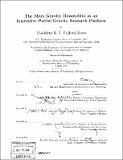The Mars Gravity Biosatellite as an innovative partial gravity research platform
Author(s)
Fulford-Jones, Thaddeus R. F
DownloadFull printable version (77.98Mb)
Other Contributors
Massachusetts Institute of Technology. Dept. of Aeronautics and Astronautics.
Advisor
Jeffrey A. Hoffman.
Terms of use
Metadata
Show full item recordAbstract
The Mars Gravity Biosatellite is an unprecedented independent spaceflight platform for gravitational biology research. With a projected first launch after 2010, the low Earth orbit satellite will support a cohort of fifteen 14.5- to 25.5-week-old female BALB/cByJ mice for up to five weeks. During this time, the spacecraft will rotate at a rate of 31.6 rpm to generate Mars-equivalent artificial gravity of magnitude 0.38-g. Reentry capability will permit the return of live specimens to the Earth's surface at the culmination of the study. The proposed first mission aims to explore the physiological impacts on mice of 0.38-g. On board the Mars Gravity Biosatellite, a video acquisition and digitisation system will enhance in-flight collection of data on sensorimotor adaptation. As part of this thesis, a rotational ground control system has been designed and constructed at MIT. The apparatus incorporates a video processing module similar to that baselined for the mission. It also features the first custom-designed gondola centrifuge that accommodates up to four singlyhoused rodents in flight-equivalent habitat modules. At a rotation rate of 31.6 rpm, the centripetal acceleration experienced by each animal is less than 1.07-g. The 0.34 m radius of rotation is equivalent to that of the orbital vehicle. A behavioural study with four BALB/cByJ mice explores the effects of chronic rotation alone and confirms that they can be quantified and therefore decoupled from the anticipated on-orbit effects of rotation-induced Mars-equivalent gravity. The results provide justification for the scientific validity of the Mars Gravity Biosatellite as a rotating spaceflight platform. In addition, details are presented on the design, implementation, test and operation of a two-mouse closed-loop environmental control and life support system (ECLSS). The ground-based assembly is colocated with the centrifuge, and the entire apparatus is enclosed within a sealed zero-pressure urethane/polyethylene membrane. It incorporates scaled-down versions of a subset of flight-equivalent atmospheric reconditioning subassemblies together with sensors, actuators and a computer to perform autonomous feedback-driven supervisory control. (cont.) Data is presented that validates a system that includes oxygen replenishment, carbon dioxide scrubbing via reaction with lithium hydroxide, ammonia removal using acidtreated activated charcoal, and humidity control with a custom-designed condensing heat exchanger. Results of a multi-week test represent an experimental proof-of-concept for the Mars Gravity Biosatellite's ECLSS strategy, showing good control of environmental parameters within specified ranges. The work presented in this thesis offers four primary contributions to aerospace biomedical engineering and rodent behavioural science: 1. Preliminary design and operations plans for the Mars Gravity payload. This thesis claims specific contributions in the areas of electronics, instrumentation, software and systems-level design of the payload module. 2. The first direct measurement of the influence of chronic rotation on mice in flight-like habitats at 31.6 rpm. The first in-centrifuge use of video-based behavioural analysis. 3. Proof-of-concept justification for the Mars Gravity Biosatellite ECLSS strategy. 4. The conception, design, implementation and operation of the first integrated ground test apparatus to combine chronic rotation capability with an ECLSS testbed.
Description
Thesis (Ph. D.)--Massachusetts Institute of Technology, Dept. of Aeronautics and Astronautics, 2008. Includes bibliographical references (leaves 269-275).
Date issued
2008Department
Massachusetts Institute of Technology. Department of Aeronautics and AstronauticsPublisher
Massachusetts Institute of Technology
Keywords
Aeronautics and Astronautics.